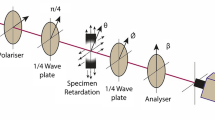Abstract
The CAdisc-L is a polycarbonate urethane lumbar intervertebral disc prosthesis that aims to replicate the mechanical properties of a natural disc as closely as possible. In this work, Small Angle X-ray Scattering (SAXS) was used to investigate the variation in composition across prototype disc samples containing annulus and nucleus regions separated by a graduated region. An empirical data analysis method was developed involving the calculation of intensity ratios, since the SAXS data did not readily fit any of the standard analysis models. Calibration samples were used to quantify the variation in SAXS response with composition and a linescan method was employed to ascertain the change in composition across discs manufactured with different graduated region volumes. The graduated region width increases with the volume incorporated into it during manufacture, as expected, but the properties do not vary linearly across the graduated regions. The method developed during this work can be adapted for use with any series of polymer samples that shows a systematic variation in SAXS behaviour with composition.









Similar content being viewed by others
References
Bogduk N. Clinical anatomy of the lumbar spine and sacrum. 3rd ed. Edinburgh: Churchill Livingstone; 1997.
An H, Boden SD, Kang J, Sandhu HS, Abdu W, Weinstein J. Summary statement––emerging techniques for treatment of degenerative lumbar disc disease. Spine. 2003;28:S24–5.
Boden SD, Balderston RA, Heller JG, Hanley EN, Zigler JE. An AOA critical issue––disc replacements: this time will we really cure low-back and neck pain? J Bone Jt Surg. 2004;86A:411–22.
Szpalski M, Gunzburg R, Mayer M. Spine arthroplasty: a historical review. Eur Spine J. 2002;11:S65–84.
Szycher M. Szycher’s handbook of polyurethanes. Boca Raton: CRC Press; 1999.
Woods G. The ICI polyurethanes book. 2nd ed. New York: ICI Polyurethanes and John Wiley & Sons; 1990.
Lamba NMK, Woodhouse KA, Cooper SL. Polyurethanes in biomedical applications. Boca Raton: CRC Press LLC; 1998.
Vermette P, Levesque S, Griesser HJ. Biomedical applications of polyurethanes. TX: Landes Bioscience; 2001.
Roe R-J. Methods of X-ray and neutron scattering in polymer science. New York: Oxford University Press; 2000.
Glatter O, Kratky O. Small angle x-ray scattering. London: Academic Press; 1982.
Guinier A. X-ray diffraction in crystals, imperfect crystals and amorphous bodies. San Francisco: W.H. Freeman; 1963.
Schmidt P. Small-angle scattering studies of disordered, porous and fractal systems. J Appl Crystallograph. 1991;24:414–35.
Laity PR, Taylor JE, Wong SS, Khunkamchoo P, Norris K, Cable M, et al. A review of small-angle scattering models for random segmented poly(ether-urethane) copolymers. Polymer. 2004;45:7273–91.
Guo J, Zhao M, Ti Y. Study on structure and performance of polycarbonate urethane synthesized via different copolymerization methods. J Mater Sci. 2007;42:5508–15.
Van Bogart JWC, Lilaonitkul A, Lerner LE, Cooper SL. Morphology and properties of short segment block copolymers. J Macromolecular Sci Phys. 1980;B17:267–301.
NanoSTAR SAXS System: User’s Manual. Vol. 2. Bruker SAXS; 2003.
Acknowledgements
The authors would like to acknowledge Dr Peter Laity for helpful discussions about polyurethanes and SAXS, and Dr Scott Johnson and Steven Scott at Ranier for guidance and help with sample manufacture respectively. Funding for this research was gratefully received from the EPSRC and Ranier Technology Ltd.
Author information
Authors and Affiliations
Corresponding author
Rights and permissions
About this article
Cite this article
Gwynne, J.H., Cameron, R.E. Using small angle X-ray scattering to investigate the variation in composition across a graduated region within an intervertebral disc prosthesis. J Mater Sci: Mater Med 21, 787–795 (2010). https://doi.org/10.1007/s10856-009-3869-z
Received:
Accepted:
Published:
Issue Date:
DOI: https://doi.org/10.1007/s10856-009-3869-z




